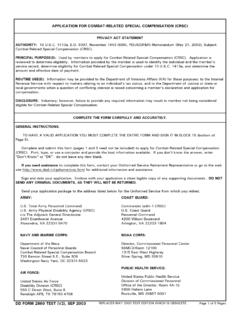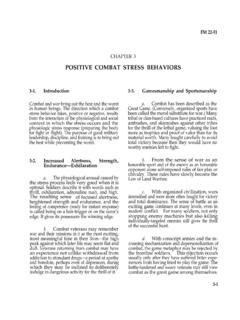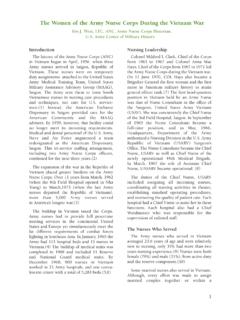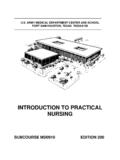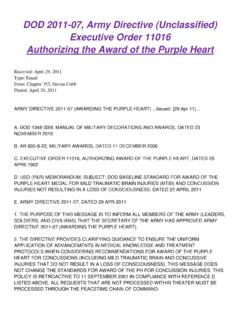Transcription of ORGANIZATION AND FUNCTIONS OF ARMY …
1 FM 22-51. APPENDIX B. ORGANIZATION AND FUNCTIONS OF army medical . department combat stress control UNITS. B-1. Introduction full range of combat intensities and operational scenarios including war and operations other combat stress control is now recognized as an than war. army medical department functional area for doctrinal and planning purposes. As such, it is b. There are six major combat stress distinguished from the other nine army medical control programs or FUNCTIONS which have dif- department functional areas of health service ferent relative importance in different scenarios. support which are The usual order of priority is as follows: a. Patient evacuation and medical (1) Consultation.
2 Liaison, preven- regulating. tive advice, education programs, planning, and stress control interventions to supported unit b. Hospitalization. commanders and staff. c. Health service logistics/blood man- (2) Reorganization (reconstitution). agement. support. Assistance at field locations to battle fatigue units which are withdrawn for rest, reor- d. Dental services. ganization, and integration of new replacements. e. Veterinary services. (3) Proximate neuropsychiatric tri- age. Sorting battle fatigue cases based on where f. Preventive medicine services they can be treated to maximize return to duty, separating out true neuropsychiatric or medical /. g. Area medical support.
3 Surgical patients. h. Command, control , communications, (4) Stabilization. Immediate, short- computers, and intelligence (C4I). term management and evaluation of severely disturbed battle fatigue casualties, neuropsy- i. medical laboratory services. chiatric, and alcohol and drug misuse cases to determine return to duty potential or to permit safe evacuation. B-2. army medical department combat stress control Program (5) Restoration. One to three days of rest, replenishment, and activities to restore a. combat stress control refers to a confidence of battle fatigue casualties at forward . coordinated program for the prevention and treat- medical units. ment of battle fatigue and other harmful stress - related behaviors.
4 combat stress control is (6) Reconditioning. An intensive implemented by mental health personnel organic 4- to 21-day program of replenishment, physical to units and by specialized medical combat stress activity, therapy, and military retraining for control units which are a corps-level (or echelon battle fatigue casualties and neuropsychiatric above corps) asset. The combat stress control cases (including alcohol and drug misuse) who ORGANIZATION must function flexibly across the require this to return to duty. B-1. FM 22-51. B-3. Basic Tenets of army medical De- military life and that they want to succeed. This partment combat stress control presumption can only be displaced by a thorough evaluation which proves the contrary, or by fail- a.
5 army medical department combat ure to improve after sufficient expert treatment. stress control is unit -identified and mission- oriented. b. army medical department combat stress control is proactive and prevention- (1) The combat stress control con- oriented. cept differs from conventional clinic or community mental health in its explicit identification with and utilization of the strengths of army organi- (1) combat stress control person- nel/units dedicate much of their time and zation and ethics. resources to activities which assist the commanders of units in controlling stressors. (2) Mental health personnel as- They identify stress problems before they lead signed combat stress control duties are clearly to dysfunction or stress casualties.
6 This early identified as members of a specific army TOE identification permits the retention and recovery unit . They may be organic members of line of mildly and moderately overstressed soldiers, medical units (such as the mental health section in their units, on duty status. of the division's medical support company or the corps' area support medical battalion), or they may be members of a medical combat stress (2) Even when providing reactive control unit which has a formal support treatment to heavily overstressed soldiers who relationship with the line units (such as a medical are in crisis, combat stress control personnel detachment or medical company, combat stress continually look for the primary causal factors control ).
7 (stressors). They work with the chain of com- mand and the chain of support to gain control of (3) combat stress control person- the stressors or control stress which may nel work closely with the chain of command and adversely affect soldiers and their families. The the chain of support in the context of the objective is not only to help the afflicted soldiers supported units' changing missions. They work and return them to effective duty, but also to in the supported units' locations, or as close as is prevent future affliction in others. feasible under the tactical conditions. (3) Even when overcommitted to (4) Mental health/ combat stress treating mass casualties, combat stress control control personnel also work with the individual units remain alert and prepared to reallocate soldiers and (in peacetime) with the soldier's resources.
8 When necessary, combat stress control family members. However, these soldiers and resources deploy to support units in forward families are considered valued members of the areas. There, they provide early preventive supported unit ; they are not labeled as patients intervention for stressed soldiers and assist or clients. combat stress control personnel begin command to gain control of the correctable with a presumption of normality (that the soldier stressors. The intent of early preventive inter- [or family member] is a normal, well-intentioned vention is to . human being). They presume that these soldiers or family members are trying in good faith to Minimize the flow of master the sometimes excessive stressors of battle fatigue casualties.
9 B-2. FM 22-51. Provide treatment for and during combat operations. Their assets are not return to duty of soldiers. sufficient to provide longer treatment for large numbers of battle fatigue or neuropsychiatric Minimize the risk of casualties without sacrificing their other critical future suffering and disability (prevent PTSD). preventive and staff FUNCTIONS . c. combat stress control on Today's B-4. Organizational and Operational Battlefield. On today's battlefield, each maneuver Concept for army medical Depart- brigade covers a larger and more fluid area and ment combat stress control has greater fire power and responsibility than did a WWII division. The army operations concept a.
10 Organic Mental Health Sections. makes the brigades even more the basic war- Mental health personnel are organic to medical fighting echelon. Winning the first battles will elements of divisions, separate brigades, and the be critical and may require reconstitution of area support medical battalion. attrited units and rapid return of temporarily disabled soldiers to their units. The organic (1) Division mental health sections division mental health personnel must be have a psychiatrist, a social work officer, a clinical reinforced if cases are to be restored in the brigade psychologist, and seven behavioral science spe- and division support areas. Separate brigades cialists.
